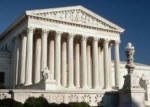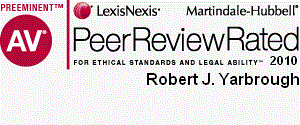Newsletter Issue 64 - June 2014
In this issue:
Supreme Court kills Aereo
Trademark for 'Redskins'
Supreme Court IP docket
Ask Dr. Copyright ...
Dear Doc:
Ever since you wrote about Aereo, the company with bazillions of
tiny TV antennas and video recorders, I have been waiting for them
to come to my town, so that I could get a decent television picture
(no more of that digital BRAAAAP every 16 seconds unless I stand
next to the TV holding up the antenna like some version of Lady
Liberty!) What's this I hear about six old folks deciding to shut
down this wonderful service?
Signed,
My Arm Is Getting Really Tired
Dear MAIGRT:
On June 25, by a 6-3 majority, the Supreme Court decided that
Aereo's service violated the copyrights of the broadcasters. Now, I
have to say that the Doc is having a hard time understanding this
ruling. As I wrote in a past article, it seemed under the decision
in the Sony Betamax case, that Aereo was just doing the same thing
as having a videotape recorder: allowing a consumer to receive a
free, over-the-air broadcast using an antenna, recording it, and
playing it back later for herself. The difference was the location
of the antenna, recorder, and screen. In 1976, the antenna was on
your roof, connected by a 50' wire to the recorder in your den,
which was then connected by a 10' wire to your TV. For Aereo, the
antennas were on a roof somewhere (but not yours), connected to the
recorder by the Internet, which was connected to your screen (TV,
computer, tablet, or smart phone) also by the Internet. Like phones
(which used to use long wires, and now use the Internet) and faxes
(same), and movie rentals (your car going to Blockbuster, now
Netflix over the Internet)... well, you see where this is going.
Nope! Not so fast. The grandmas and grandpas on our Supreme Court
have just stepped onto the porch and yelled at Aereo to stay off
their lawns. The majority expressly said that because Aereo's system
appears to be similar to a cable television system, that's good
enough. Never mind that the system does nothing until a subscriber
"tunes" in a program, and never mind that each antenna and recording
is individual and private. If it looks like a duck...shut it down.
As the Court said, "why should any of these technological
differences matter? They concern the behind-the-scenes way in which
Aereo delivers television programming to its viewers' screens. ...
Why would a subscriber who wishes to watch a television show care
much whether images and sounds are delivered to his screen via a
large multisubscriber antenna or one small dedicated antenna,
whether they arrive instantaneously or after a few seconds' delay,
or whether they are transmitted directly or after a personal copy is
made?"
The three dissenting justices think that these things do matter.
They term the majority's approach "Guilt By Resemblance" but as they
are the minority, the public is left to wonder what will become of
Aereo. The company's founder, Barry Diller, who also started the Fox
Network, said that it's, "Game Over". Score another one for big
business.
One thing, however, is true: more and more people are "cutting the
cord" and refusing to subscribe to cable television services. The
next few years will be bumpy, but in the end, innovative services
like Aereo are likely to prevail. Broadcast television started out
as a public trust, using the public airwaves. Anyone was free to
receive the signals. Broadcast television, operated in the public
interest is dying. That seems to be fine with the cable companies.
It seems to be fine with the FCC. The Doc likes a good book, anyway.
Interested in innovating new services? Talk to the attorneys at
LW&H. They receive, store, and respond, without engaging in
unauthorized public performances.
Skins Lose Trademark Game Before the TTAB
If you haven't heard by now, this past week
the Trademark
Trial and Appeal Board ("TTAB") of the United States Patent and
Trademark Office canceled several trademarks owned by Pro-Football,
Inc. ("Pro Football") for the term "Redskins" on grounds that the
marks were "disparaging to Native Americans." This issue has been
around for some time and has been the subject of previous lawsuits
in which Pro Football has prevailed. Rather than try to summarize The TTAB's
177-page opinion in this short column, let's briefly examine two
questions raised by the decision:
• Under what authority does the TTAB act to cancel a trademark for
being disparaging?
• Is Pro Football free to use the term "Redskins" even though the
TTAB has cancelled its marks?
When a party wishes to cancel another party's trademark, it has two
options: file a trademark cancellation proceeding with the TTAB, an
administrative body that has the legal responsibility of
adjudicating issues related to trademark applications and
registrations, or file a lawsuit in United States federal court. In
the Redskins matter, the "plaintiffs," five native Americans, chose
the administrative route.
Section 2 of the Lanham Act, the law that controls trademarks,
spells out under what circumstances a trademark may not be
registrable, the first criterion being any trademark that
Consists of or comprises immoral, deceptive, or scandalous matter;
or matter which may disparage or falsely suggest a connection with
persons, living or dead, institutions, beliefs, or national symbols,
or bring them into contempt, or disrepute ....
15 USC 1052(a). Under this authority a court or administrative body
such as the TTAB may cancel the registration of a "disparaging"
trademark. Actually, it's not quite that simple. The important
question is how does a court determine whether a trademark is
"disparaging?" With respect to native Americans, the courts have
devised a two-part test:
[1] What is the meaning of the matter in question, as it appears
the marks and as those marks are used in connection with the goods
and services identified in the registrations?
[2] Is the meaning of the marks one that may disparage Native
Americans?
With respect to the second question, the law states that whether a
term such as "redskins" is disparaging to Native Americans, one must
reference the views of Native Americans, not the the American public
as a whole. Based upon the evidence before it, the TTAB determined
that, indeed, Native Americans viewed the term as disparaging and,
as a consequence, it cancelled Pro Football's trademark
registrations.
Okay, so now that Pro Football no longer has registered trademarks,
can it still use the term "RedSkin"? The TTAB, as it noted, does
not have the legal authority "to issue rulings concerning the right
to use trademarks." Why? That's because trademark rights arise
from use, not from registration. For example, if you have used an
unregistered trademark (referred to as a common law trademark) first
in time, you will prevail in litigation over a trademark holder that
may own a registration but began using it later in time. Because
these so-called common law rights are unaffected by a federal
registration, Pro Football is free to use "Redskin." A word of
warning! Common law trademarks are governed by state law so if
state law disqualifies disparaging marks, Pro Football has a
problem, particularly if it tries to enforce its trademarks in
court. Of course, whether continued use of "Redskins" is a good
idea from a branding and marketing perspective after all the
negative publicity is another question.
Busy, Busy, Busy
The Supreme Court has had a busy time of it in June stirring the
patent pot, with decisions in three cases and arguments in a
fourth. The general rule is that whenever the Supreme Court decides
a patent case, the law is left in worse shape than it was before.
The recent decisions are no exception. This month, we'll take a
look at Limelight v Akamai, decided June 2, 2014.
In Limelight, the Court considered "inducement of infringement."
Inducement of infringement occurs when one person causes, or
induces, another person to infringe a patent. Where the patent is
to a method of doing something, the inducement rule for many years
has been that (a) one person must induce another person to infringe
the patent, and (b) the other person must actually perform all of
the steps of the method and thus infringe the patent. The person
who caused someone else to infringe is liable for infringement, just
is the person who actually infringed.
This rule worked fine when things were made from steel and wood, but
has been a problem for Internet-implemented inventions that can be
performed over a computer network by different people in different
locations and even different countries.
The stage is set for Limelight and Akamai.
MIT owned patents relating to storage and retrieval of content over
the Internet. MIT licensed the patents to Akamai, which runs a
service utilizing the MIT patent to store and retrieve content. The
patent (and the Akamai service) involves storing large files on
servers located in different locations, and, hopefully, near the
user who wants access to the file. Local storage of the large files
allowed faster access by the user. One of the steps of the patent
is that Akamai 'tags' which of a customer's files are to be stored
in the local servers.
Limelight operates a competing service that is just like Akamai's
service, but with one important difference - Limelight does not
'tag' the files. Instead, Limelight's customers tag their own
files, using advice and assistance from Limelight. Because
Limelight does not tag the files, no one person performs all of the
steps of the patent and there is no one that Akamai can sue for
direct infringement. Because no one person performs all of the
steps of the patent, under the old rule Limelight cannot be liable
for inducement of infringement. Akamai has no remedy. Seems
unfair, doesn't it?
The Federal Circuit Court of Appeals thought so. It decided that
the old rule did not work in the information age and that
Limelight's actions in copying Akamai's business but avoiding the
patent should not be tolerated and that Limelight should be liable
for inducement of infringement.
The Supreme Court reversed and reinstated the old rule, seeing no
reason to change. As a result of the Supreme Court's decision,
Akamai is without remedy and Internet copyists are free to cut a
step from a method patent, instruct someone else to perform the
missing step, and avoid patent infringement altogether. The value
of Internet inventions, or in fact any method patent that can be
performed by different people, has just dropped.
"Be Afraid. Be Very Afraid."1

1'The Fly,' 1986, Jeff Goldblum and Geena Davis.
A cyber security firm called Norse maintains what it claims to be
a dynamic, real-time map of cyber attacks as they happen, showing
cities of origin and targets. The first thing you'll do after
viewing this constantly-changing map is update your security
software. The second is to clean the cobwebs out of your filing
cabinet.

